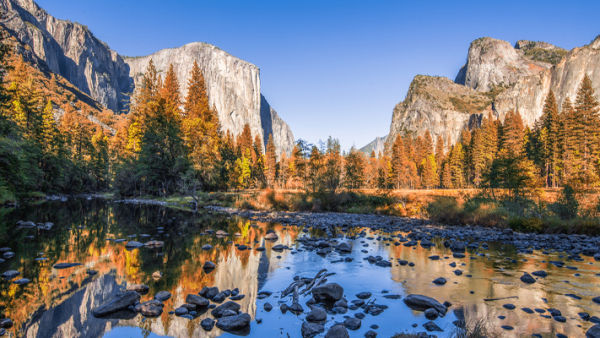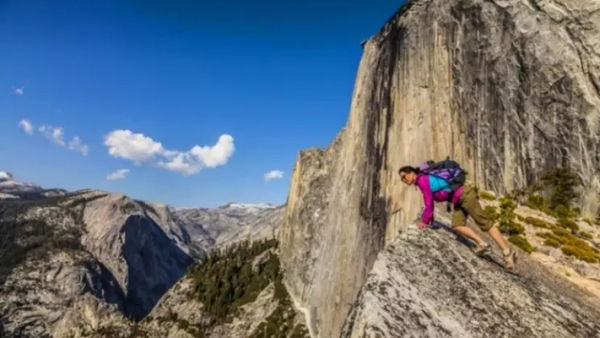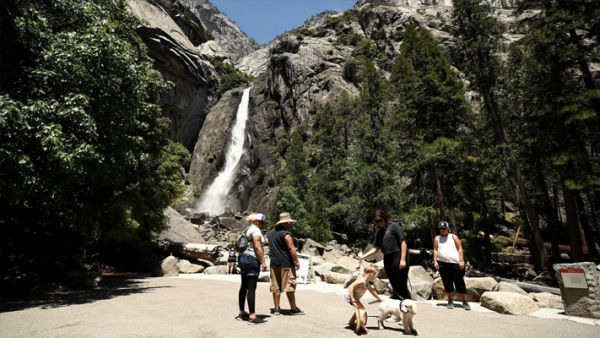Yosemite National Park is a vast protected area in the Sierra Nevada Mountains of California, covering an area of over 750,000 acres. It is located in the central-eastern portion of the state, about 200 miles east of San Francisco. The park was established in 1890 and is now a UNESCO World Heritage site.

The park is known for its spectacular granite cliffs, waterfalls, and giant sequoia trees. Some of the most iconic landmarks in the park include El Capitan, Half Dome, and Yosemite Falls. Visitors can enjoy a range of activities in the park, such as hiking, camping, rock climbing, fishing, horseback riding, and bird watching.
Yosemite National Park is home to a wide variety of wildlife, including black bears, mountain lions, coyotes, mule deer, and bighorn sheep. The park is also known for its diverse bird species, including the peregrine falcon, bald eagle, and great grey owl.
Yosemite has a rich history and has been inhabited by Native Americans for thousands of years. The park was also home to some of the earliest pioneers and settlers in California. Yosemite has been a popular tourist destination since the mid-19th century, and today it receives millions of visitors each year.
Yosemite National Park is unique for several reasons:
1. Stunning natural features: Yosemite's dramatic granite cliffs, cascading waterfalls, crystal-clear streams, and groves of giant sequoia trees create a breathtaking landscape that is unparalleled anywhere else in the world.
2. Rich biodiversity: Yosemite is home to a remarkable variety of plant and animal species, including many that are endemic to the Sierra Nevada region. This diversity is due to the park's location at the intersection of several different ecosystems, ranging from high-altitude alpine tundra to low-elevation chaparral.
3. Cultural significance: Yosemite has been a sacred place for indigenous peoples for thousands of years, and it has also played an important role in the history of American conservation and environmentalism. The park's cultural significance is reflected in its many historic buildings, trails, and landmarks.
4. Recreational opportunities: Yosemite offers a wide range of recreational opportunities, from hiking and camping to rock climbing and winter sports. This makes it a popular destination for people of all ages and interests.
5. Accessibility: Despite its remote location, Yosemite is relatively easy to access by car or bus from major cities in California. This makes it a popular destination for both domestic and international visitors.

Things to Do
There are many things to do in Yosemite National Park, depending on your interests and the time of year. Here are some popular activities:
1. Hiking: Yosemite has hundreds of miles of trails that offer a range of difficulty levels and scenic vistas. Some popular hikes include the Mist Trail, Half Dome, and the John Muir Trail.
2. Rock Climbing: Yosemite is one of the world's premier rock climbing destinations, with granite walls that attract climbers from around the world. The park offers a range of climbing options, from beginner routes to multi-pitch big walls.
3. Water Activities: Yosemite has several rivers and lakes that are perfect for swimming, fishing, and kayaking. Some popular spots include the Merced River, Tenaya Lake, and the Tuolumne River.
4. Wildlife Viewing: Yosemite is home to a wide range of animals, including black bears, mule deer, and coyotes. Visitors can take guided wildlife tours, go bird watching, or simply keep an eye out for wildlife while hiking.
5. Winter Sports: In the winter, Yosemite becomes a wonderland of snow and ice, with opportunities for cross-country skiing, snowshoeing, and ice skating.
6. Ranger Programs: Yosemite offers a variety of ranger-led programs, including guided hikes, campfire talks, and educational programs for kids. These programs are a great way to learn more about the park's history, geology, and ecology.
7. Scenic Drives: Yosemite has several scenic drives that offer stunning views of the park's natural features. Some popular drives include the Tioga Road, Glacier Point Road, and the Wawona Road.
Must See Places
Yosemite National Park is home to many stunning natural features and iconic landmarks. Here are some must-see places to visit in the park:
1. Yosemite Valley: The Yosemite Valley is a must-see destination, surrounded by towering granite cliffs and home to the park's most famous landmarks, including Half Dome, El Capitan, and Yosemite Falls.
2. Glacier Point: From Glacier Point, visitors can enjoy stunning panoramic views of Yosemite Valley, Half Dome, and Yosemite's high country. The viewpoint is easily accessible by car or by hiking the 4-mile trail from the valley floor.
3. Mariposa Grove: Mariposa Grove is home to over 500 giant sequoia trees, including the famous Grizzly Giant and California Tunnel Tree. Visitors can hike through the grove or take a guided tour to learn more about these magnificent trees.
4. Tuolumne Meadows: Located at an elevation of 8,600 feet, Tuolumne Meadows offers a high-country oasis of alpine meadows, clear streams, and granite domes. Visitors can hike, fish, or simply enjoy the stunning scenery.
5. Hetch Hetchy Valley: The Hetch Hetchy Valley is a hidden gem in Yosemite, with a stunning reservoir, cascading waterfalls, and granite cliffs. Visitors can hike along the reservoir or take a guided tour to learn more about the valley's history and ecology.
These are just a few of the many must-see places in Yosemite National Park. No matter where you go in the park, you are sure to be surrounded by stunning natural beauty and awe-inspiring landscapes.

Best Time to Visit
The best time to visit Yosemite National Park depends on your preferences and the activities you want to do. Here's a breakdown of the different seasons:
1. Spring (March-May): Spring is a beautiful time to visit Yosemite, with waterfalls at their peak and wildflowers in bloom. The weather can be unpredictable, with occasional rain and snow, but the crowds are generally smaller than in summer.
2. Summer (June-August): Summer is the busiest time of year in Yosemite, with warm weather and long days. The park's most popular attractions, like Yosemite Valley and Glacier Point, can be crowded, but there are plenty of trails and less-visited areas to explore.
3. Fall (September-November): Fall is another beautiful time to visit Yosemite, with fewer crowds and milder weather. The fall colors can be spectacular, especially in October, and hiking is comfortable during the day. However, some park facilities start to close as the season winds down.
4. Winter (December-February): Winter is a magical time to visit Yosemite, with snow covering the landscape and a peaceful silence throughout the park. Many facilities are closed, but visitors can enjoy cross-country skiing, snowshoeing, and other winter sports.